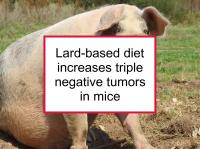A study has reported that a high-fat lard-based diet resulted in higher cancer incidence and larger mammary tumors than a low-fat diet in a mouse model of triple negative (ER-/PR-/HER2-) breast cancer. The study was designed to investigate the impact of a high-fat diet compared to a low-fat diet on mammary tumor development.
Latest research finds lard diet increases tumor number and size
To conduct the study, the authors weaned 16 C3(1)SV40TAg mice at age three to four weeks and then assigned them to one of two dietary groups. The high-fat diet group were fed 5.3 kcal/g, including 60% of calories from lard, whereas the low-fat group received 3.7 kcal/g, including 17.2% of calories from vegetable oil. The mice were administered specialized MRIs of their mammary glands at 12 weeks, after which the animals were sacrificed. The mammary glands were then removed and formalin fixed for additional MRI studies.
Based on the live mouse MRIs, the lard-fed mice were found to have an average of 3.88 tumors whereas the low-fat group had an average of 1.25 tumors. The average tumor volume was also higher in the lard-fed group (0.53 mm3) than the low-fat group (0.20 mm3). Analysis of the remaining MRIs as well as histology images showed that the lard-fed mouse mammary glands had higher breast density, irregular and enlarged ducts, dilated blood vessels, increased fat tissue, and greater tumor invasion.
The authors conclude that the high-fat lard-based diet resulted in higher cancer incidence and larger mammary tumors. The authors also comment that, unlike other imaging techniques for assessing environmental effects on mammary cancer growth, MRI facilitates multiple accurate measurements and reliable detection of small tumors as well as assessment of the three-dimensional distribution of tumors over time.
Please see our article on triple negative diet for more information.
